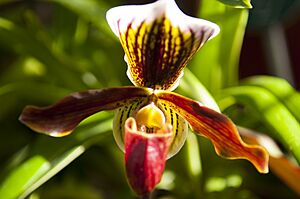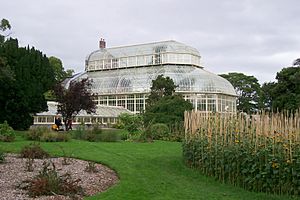National Botanic Gardens (Ireland) facts for kids
Quick facts for kids National Botanic Gardens |
|
|---|---|
| Garraithe Náisiúnta na Lus | |
 |
|
| Lua error in Module:Location_map at line 420: attempt to index field 'wikibase' (a nil value). | |
| Type | Botanic Garden |
| Location | Glasnevin, Dublin |
| Area | 19.5 ha (48 acres) |
| Created | 1795 |
| Operated by | Office of Public Works |
| Status | Open all year |
| Website | www.botanicgardens.ie |
The National Botanic Gardens (in Irish: Garraithe Náisiúnta na Lus) is a special garden for plants in Glasnevin, Ireland. It's about 5 kilometers (3 miles) north-west of Dublin city center. This amazing garden covers 19.5 hectares (about 48 acres). It sits between Glasnevin Cemetery and the River Tolka.
The gardens were started in 1795 by the Dublin Society. Today, the Irish government owns and runs them through the Office of Public Works. You can find around 20,000 different living plants here. There are also millions of dried plant samples! The gardens have some really cool and old greenhouses. This Glasnevin site is the main home of the National Botanic Gardens of Ireland. They also have another garden and a tree collection (called an arboretum) in Kilmacurragh, County Wicklow.
The gardens help with national and international projects to protect different kinds of plants and animals (this is called biodiversity). They also work on making sure we use resources in a way that helps the planet for a long time (this is called sustainable development). The gardens are very popular. They are Ireland's seventh most visited attraction. They are also the second most visited free attraction in the country!
Contents
History of the Gardens
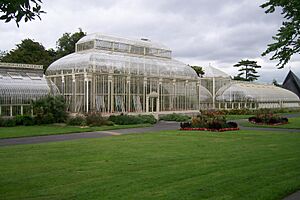
In 1795, a poet named Thomas Tickell sold his house and land in Glasnevin. The Irish Parliament bought it. They gave it to the Royal Dublin Society to create Ireland's first ever botanic gardens. You can still see a double line of yew trees from that time. They are known as "Addison's Walk."
The main goal of the gardens back then was to learn more about plants. This knowledge would help with farming, medicine, and making dyes. The gardens were also the first place in Ireland where scientists found the plant disease that caused the terrible Great Famine from 1845 to 1847. During the famine, a lot of research was done here to try and stop the disease.
Walter Wade and John Underwood were the first Director and Superintendent. They planned how the gardens would look. But after Wade died in 1825, the gardens didn't do so well for a few years. Then, in 1834, a new Director named Ninian Nivan brought new life to the gardens. He even redesigned some parts. This work continued with other Directors until the late 1960s.
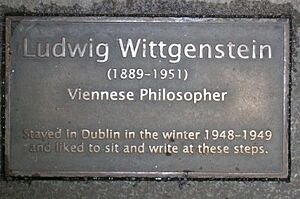
In 1877, the gardens became part of the government's care.
A famous thinker named Ludwig Wittgenstein lived and worked in Ireland in 1948 and 1949. He often came to the Palm House to sit and write. There's a special plaque on the steps where he used to sit to remember him.
What You Can See and Do
The National Botanic Gardens are a great place for tourists to visit. They are also a lovely spot for people who live nearby. Entry is free! The gardens are also a very important place for plant research and training. They even breed many beautiful orchids here.
The soil at Glasnevin is quite alkaline. This means some plants, like rhododendrons, that prefer acidic soil need special areas to grow. But the gardens still have many different outdoor areas. These include a rockery (for rock plants), a herbaceous border (for flowering plants), a rose garden, a bog garden, and an arboretum (for trees). There's even a vegetable garden!
The National Herbarium is also located here. This is a huge collection of dried plant samples. The museum part has about 20,000 plant products. These include fruits, seeds, wood, fibers, and plant extracts. They have been collected over the gardens' 200-year history. The gardens also have famous and historically important collections of orchids.
The newly fixed-up Palm House is home to many plants from warm, tropical places. In 2002, a new building was added. It has a cafe and a big room for talks and lectures. The gardens also look after the arboretum at Kilmacurragh, County Wicklow. This place is known for its cone-bearing trees (conifers) and plants that don't like alkaline soil. It's about 50 kilometers (31 miles) south of Dublin.
A special gate connecting the gardens to Glasnevin Cemetery was opened again recently.
Amazing Glasshouses
The gardens have some very important and beautiful glasshouses. These include the Palm House and the Curvilinear Range.
The Great Palm House is in the southern part of the gardens. It connects to the cactus house on one side and the orchid house on the other. The main building is huge! It's 65 feet (20 meters) tall, 100 feet (30 meters) long, and 80 feet (24 meters) wide.
The Palm House was first built in 1862. It was needed to hold all the new tropical plants that needed warm, protected places to grow. The first building was made of wood and wasn't very strong. A big storm blew it down in 1883. Richard Turner, a famous iron worker from Dublin, suggested building a stronger iron house. So, in 1883, work began on a new iron structure. Parts of the building were made in Scotland and then shipped to Ireland.
By the early 2000s, the Palm House was in bad shape. After more than 100 years, the iron and wood parts were falling apart. Many glass panes were breaking because the building was unstable. To fix it, the house was completely taken apart into over 7,000 pieces! Each piece was labeled and sent away for repair. The tall iron columns inside were replaced with new ones that looked just like the originals. Special paint was used to protect the building from the warm, wet air inside. The glass panes were made safer, too. The Palm House reopened in 2004 after a long process of fixing it up and replanting all the plants.
The Curvilinear Range was finished in 1848 by Richard Turner. It was made even bigger in the late 1860s. This building has also been restored. The restoration work even won an award called the Europa Nostra award for excellent conservation architecture!
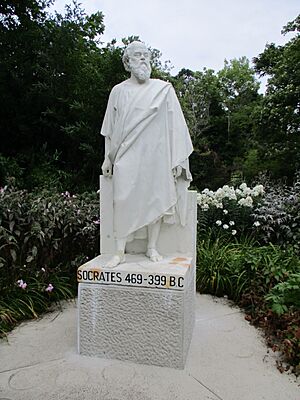
There is also a third group of glasshouses: the Aquatic House, the Fern House, and the original Cactus House. These buildings were closed in the early 2000s and are now being fixed up. Because these glasshouses held special plants, some, like the Giant Amazonian Water Lily, haven't been grown in the gardens since these buildings closed.
Learning About Plants
Building on the gardens' history of teaching, the Teagasc College of Amenity Horticulture is located right here. It offers full-time and part-time courses. These courses train students for jobs in the plant and garden industry. The training is done with help from the Office of Public Works (OPW), Dublin's local parks departments, and the Golfing Union of Ireland.
Directors of the Gardens
The Director is the main person in charge of the Gardens. They even have a house on the site! Here are some of the people who have been Directors:
- Dr Walter Wade (until 1825)
- Samuel Litton (1825–1834)
- Ninian Niven (1834–1838)
- Dr David Moore (1838–1879)
- Sir Frederick William Moore (1879–1922)
- J. W. Besant (1922–1944)
- Dr T. J. Walsh (1944–1968)
- Aidan Brady (1968–1993)
- Donal M. Synnott (1994–2004)
- Dr Peter Wyse Jackson (2005–2010)
- Dr Matthew Jebb (2010–present)
See also
 In Spanish: Jardín botánico nacional de Irlanda para niños
In Spanish: Jardín botánico nacional de Irlanda para niños
- National Botanic Gardens Kilmacurragh
- List of Irish botanical illustrators
- List of Irish plant collectors
- Griffith Park, Dublin
- The Ferns of Great Britain and Ireland


